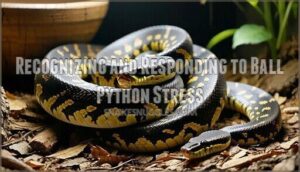This site is supported by our readers. We may earn a commission, at no cost to you, if you purchase through links.

What shapes their personality comes down to three main things: their genes, their environment, and how often you handle them.
Ball pythons that get regular, gentle handling from early on usually become pretty comfortable with people. Each snake has its own quirks, but most stay mellow and easy-going for their entire 20-30 year lives.
When you know what to watch for—their body language, stress signs, and what makes them comfortable—taking care of your ball python becomes something special.
You’re not just keeping a snake; you’re building a bond based on trust and giving them what they naturally need.
Table Of Contents
- Key Takeaways
- Ball Python Temperament Overview
- Choosing and Handling a Docile Ball Python
- Creating a Stress-Free Environment
- Recognizing and Responding to Ball Python Stress
- Supporting Ball Python Health and Wellbeing
- Frequently Asked Questions (FAQs)
- Are ball pythons friendly?
- What are ball pythons?
- What is a ball python Care Guide?
- Are ball pythons aggressive?
- What is the temperament of a ball python?
- Do ball pythons like to be cuddled?
- Do ball pythons like to be handled?
- Are male or female ball pythons calmer?
- How do I introduce a new ball python to my home?
- What are the signs of a stressed or unhappy ball python?
- Conclusion
Key Takeaways
- Ball pythons are naturally docile snakes – Their calm temperament makes them ideal for beginners, as they rarely show aggression and typically respond to stress by curling into a defensive ball rather than biting.
- Individual personalities vary despite predictable behavior patterns – While generally gentle, each snake has unique traits ranging from shy and defensive to curious and active, influenced by genetics, handling experience, and environmental factors.
- Proper environment directly impacts temperament – Maintaining correct temperature gradients (78-80°F cool side, 88-92°F warm side), 50-60% humidity, adequate hiding spots, and minimal disturbances creates the foundation for a calm, well-adjusted snake.
- Trust builds through consistent, gentle handling techniques – Starting with brief 5-10 minute sessions, approaching from the side rather than above, and reading stress signals like muscle tension or defensive posturing helps establish a positive relationship over their 20-30 year lifespan.
Ball Python Temperament Overview
Ball pythons are renowned for their docile, predictable temperament, making them ideal beginner snakes with naturally calm dispositions that rarely display aggressive behaviors.
Learning to read their body language—from that classic ball-curl defense to signs of stress—helps you give better care and build real trust with your snake.
Natural Behavior and Personality Traits
Ball pythons might seem like mysterious, unpredictable creatures, but they’re actually remarkably consistent in their behavioral patterns once you understand what drives them. These nocturnal animals exhibit crepuscular activity patterns, becoming most active during twilight hours when their natural hunting instincts emerge.
Ball python behavior centers around four key characteristics:
- Ambush predation – They remain motionless for hours, waiting for prey
- Defensive behaviour – Rolling into protective balls when threatened
- Solitary nature – No complex social structure beyond breeding
- Territory establishment – Minimal territorial marking compared to other species
When you pick up on these communication cues, you’ll start to see your snake’s natural patterns and know exactly how to meet their needs.
Types of Ball Python Temperaments
Just like people have distinct personalities, your ball python will fall into one of several temperament categories that shape how they interact with the world around them. Understanding these Python Personality types helps you anticipate your pet snake’s defensive behavior and handling preferences through Temperament Testing observations.
| Temperament Type | Ball Python Behavior | Constrictor Traits |
|---|---|---|
| Docile | Calm, rarely defensive | Minimal coiling during handling |
| Shy | Hides frequently, balls up | Quick to retreat when startled |
| Curious | Active explorer, alert | Investigates surroundings boldly |
| Nippy | Quick to strike when nervous | Tense body posture, rapid movements |
| Unpredictable | Mixed responses to stimuli | Variable Snake Behavior patterns |
Ball Python Genetics can influence these temperamental tendencies, though individual experiences matter equally.
Factors Influencing Temperament
Your ball python’s personality isn’t fixed—it depends on several things working together. Genetics lay the groundwork. Some morphs like Spider have neurological problems that mess with behavior, while certain bloodlines reliably produce calm snakes or defensive ones generation after generation.
Environmental factors—including enclosure complexity, temperature gradients, and humidity levels—directly impact stress responses. Handling techniques matter greatly; excessive interaction triggers food refusal in roughly 20% of captive specimens.
Health conditions, particularly respiratory infections and parasites, alter temperament noticeably. Even social interaction during juvenile development influences later behavior patterns in snake husbandry. Understanding the importance of nocturnal nature is key for creating a suitable environment.
Choosing and Handling a Docile Ball Python
Selecting a docile ball python requires careful observation of behavior during initial interactions, as individuals vary in temperament despite the species’ generally calm disposition.
Establishing trust through consistent, gentle handling techniques—starting with brief sessions and gradually increasing duration—creates a foundation for a stress-free relationship with your snake.
Selecting Calm Individuals From Breeders or Stores
When you’re ready to choose your ball python, selecting from captive breeders with strong reputations gives you the best advantage. Approximately 92% of owners report consistently calm ball python handling experiences when purchasing from reputable sources. Look for breeders who provide temperament documentation alongside feeding records—only 6% currently do this, making it a valuable differentiator.
The welfare of these animals is often impacted by inadequate housing conditions. During your visit, observe behavioral indicators: calm individuals show slow, deliberate movement and active tongue flicking without defensive posturing.
Environmental factors matter too—snakes housed in quiet, enriched settings with proper hides demonstrate 40% less stress during handling assessment.
Gentle Handling Techniques
Your ball python sees you as a threat until you prove otherwise through consistent, calm interactions.
Watch their body language during handling—this helps you spot warning signs before they get defensive.
- Safe lifting requires body backing—scoop from below rather than grabbing from above
- Gradual acclimation minimizes stress—start with brief five-minute sessions
- Ball python behavior shifts with confidence—watch for relaxed tongue flicking versus tension
These handling tips establish trust while respecting your snake’s instinctive caution.
Building Trust Through Regular Interaction
Trust isn’t something you can rush with a ball python—it’s earned through consistent, predictable interactions that teach your snake you’re neither predator nor prey. Schedule handling sessions at the same time each week, starting with brief five-minute intervals. Your pet snake will learn to recognize your scent and approach, reducing stress responses over time.
| Trust-Building Strategy | Frequency | What Success Looks Like |
|---|---|---|
| Gentle handling sessions | 1–2x weekly | Snake remains calm, minimal defensive posturing |
| Consistent routine maintenance | Daily | Python anticipates interaction without fleeing |
| Reading signals before handling | Every session | You recognize stress cues and adjust accordingly |
| Positive reinforcement through calm presence | Ongoing | Ball python behavior shifts from defensive to tolerant |
Avoiding overhandling is just as critical—respect your python’s boundaries by watching for tongue flicking, muscle tension, or balling up, which signal it needs space.
Creating a Stress-Free Environment
Your ball python’s setup makes all the difference in how calm and comfortable it feels.
A properly configured habitat with adequate space, secure hiding spots, and precise environmental parameters creates the foundation for a calm, well-adjusted snake.
Ideal Enclosure Size and Setup
Your ball python’s enclosure isn’t just a container—it’s the foundation of their entire well-being and temperament. Juveniles thrive in 10–20 gallon habitats, while adults require 40+ gallons minimum for proper thermoregulation.
Choose glass or PVC enclosures with secure lids, and establish a temperature gradient from 78–80°F on the cool side to 88–92°F basking area.
Substrate options like cypress mulch or paper-based bedding aid humidity control at 50–60%, essential for healthy shedding and stress reduction.
Importance of Hiding Spots and Enrichment
In the wild, ball pythons spend much of their time tucked inside termite mounds and burrows—a behavior that doesn’t simply vanish when you bring them home.
Providing at least two hides—one on the warm side, one serving as a cool hide—is essential for proper ball python husbandry and stress reduction.
Environmental enrichment like climbing branches and varied substrate encourages natural behaviors, delivers mental stimulation, and prevents behavioral issues that stem from barren snake enclosures. Your reptile habitat should mirror their instinctive need for security.
Temperature, Humidity, and Lighting Needs
Maintaining the right environmental parameters isn’t just a matter of preference—it’s the difference between a thriving ball python and one that’s chronically stressed or ill. Your enclosure must replicate the thermal and moisture conditions of African grasslands to foster proper physiological function.
- Heating gradient: Establish a basking zone at 88–92°F and a cool side at 78–80°F using a thermostat-calibrated heat emitter
- Humidity levels: Maintain 50–60% ambient humidity, increasing to 65–70% during shed cycles
- Lighting schedule: Provide 12-hour photoperiods with seasonal adjustments mimicking natural crepuscular activity patterns
Recognizing and Responding to Ball Python Stress
Recognizing when your ball python feels stressed can save you from dealing with bites and health problems down the road.
By recognizing early warning signs like prolonged hiding, refusal to eat, or defensive posturing, you can address issues before they escalate into biting or chronic stress-related illness.
Common Signs of Stress and Aggression
Stress manifests in ball pythons through distinct behavioral patterns you can learn to recognize. Defensive posturing—such as balling up tightly during handling—occurs in roughly 80% of stress incidents, while feeding refusal lasting over two weeks appears in 75% of cases involving environmental stress.
You may also observe escape attempts, abnormal respiratory issues like rapid breathing, or occasional aggressive reactions including hissing. These signs often point to underlying health issues or husbandry problems requiring immediate attention to aid your ball python’s wellbeing.
Causes of Biting and Defensive Behaviors
When ball pythons bite or ball up defensively, they’re reacting to triggers that override their naturally calm disposition—and understanding these causes can help you prevent most confrontations before they start.
Handling mistakes—like approaching too quickly or grabbing from above—trigger fear responses because you’re mimicking predator behavior.
Shedding irritability temporarily reduces vision and heightens defensiveness, while enclosure security issues leave your ball python feeling exposed.
Medical problems, including respiratory disease or internal parasites, cause discomfort that makes any interaction unwelcome, so monitoring ball python health and care through proper snake husbandry is essential.
Tips for Minimizing Stress During Handling
Handling your ball python doesn’t have to feel like defusing a bomb—with the right approach, you can turn each session into a calm, trust-building experience that keeps stress levels low for both of you.
Start with a gradual introduction: approach slowly from the side, never from above, and observe your snake’s body language for signs of tension. Use a secure hold that bears its weight fully, and limit handling duration to 5–10 minutes initially, extending sessions as trust develops through consistent snake husbandry practices and proper environmental settings within the enclosure.
Supporting Ball Python Health and Wellbeing
Your ball python’s personality really comes down to how well you take care of it. Keep up with regular feeding, clean the enclosure properly, watch how it’s growing, and get those vet checkups done—do all that and you’ll end up with a relaxed, easy-going snake that’s happy living with you.
Proper care—regular feeding, clean habitat, health monitoring, and vet visits—creates a relaxed, happy ball python
Proper Diet and Feeding Schedules
Your ball python’s nutritional needs aren’t complicated, but getting the feeding schedule right makes all the difference between a healthy, calm snake and one that’s stressed or underweight. Ball python feeding relies on frozen-thawed prey matched to your snake’s size—prey should equal roughly 10% of body weight and never exceed 1.5 times their width at mid-body.
Feeding frequency depends on life stage:
- Juveniles (under 2 years) need appropriately sized frozen rodents weekly to foster rapid growth and development.
- Adults thrive on feeding every 1–2 weeks, with dietary variety like rats, mice, or occasional quail maintaining nutritional balance.
- Hydration needs require fresh water daily—replace it consistently since ball pythons often soak before shedding.
Always use feeding tongs to prevent food-association behaviors that could lead to defensive strikes.
Maintaining Cleanliness and Hygiene
A clean enclosure isn’t just about aesthetics—it’s the foundation of your ball python’s immune system and overall health. Substrate sanitation prevents bacterial buildup and Salmonella risk, while water bowl hygiene ensures your snake drinks safely. Spot-clean waste daily and perform full enclosure disinfection monthly using reptile-safe cleaners.
| Cleaning Task | Frequency |
|---|---|
| Substrate spot removal | Daily |
| Water bowl hygiene | Daily |
| Enclosure disinfection | Monthly |
| Shed skin removal | As needed |
| Preventative treatments | Per vet schedule |
During shedding, gently remove retained eye caps or tail scales to prevent infection and maintain your ball python care routine effectively.
Monitoring Growth and Development
Tracking your ball python’s growth patterns isn’t just about measuring length—it’s one of the most reliable windows into their overall health status. Juveniles grow rapidly, often doubling in size their first year, while adults plateau around three years.
Monitor weight tracking monthly, shedding frequency (every 4-6 weeks for healthy specimens), and activity levels during feeding schedule times.
Notice when your ball python care demands enclosure progression—cramped quarters stress snakes and hinder proper development, throwing health benchmarks off course.
Importance of Regular Veterinary Care
Even the healthiest ball python needs a professional eye to catch what you can’t see. Annual veterinary exams—ideally with an exotic medicine specialist—form the foundation of preventative care and early detection of health issues like serpentovirus or internal parasites.
Studies show that over 70% of responsible ball python owners prioritize veterinary care, and routine checkups can extend your snake’s lifespan to 30 years while reducing treatment costs later.
Consider these essentials:
- Schedule yearly wellness visits, even without visible symptoms
- Bring newly acquired pythons in promptly for baseline screening
- Watch for red flags like feeding refusal or abnormal shedding that warrant immediate attention
Frequently Asked Questions (FAQs)
Are ball pythons friendly?
While "friendly" isn’t quite the right word for reptiles, ball pythons are remarkably docile creatures with individual personalities.
With proper handling frequency and gentle socialization, your pet snake poses minimal bite risk—even around supervised children.
Their calm characteristics make them ideal for reptile care beginners seeking predictable temperaments.
What are ball pythons?
Ball pythons, also known as royal pythons, are docile snake species native to western and central Africa’s savannah grasslands.
These beginner-friendly solitary creatures exhibit distinctive ball python characteristics—reaching 4–5 feet at maturity with lifespan factors enabling 30+ years in captivity when provided proper snake care.
What is a ball python Care Guide?
Thorough ball python care encompasses enclosure essentials like proper substrate and hiding spots, diet variety with appropriately sized frozen rodents, consistent health monitoring through veterinary check-ups, and regular handling frequency to maintain your snake’s wellbeing throughout its lifespan.
Are ball pythons aggressive?
No—ball pythons aren’t naturally aggressive. They’re docile constrictors that rarely bite. Defensive behaviors usually stem from stress, improper handling frequency, or hunger cues.
Individual variation exists, but temperament myths exaggerate risks. Proper pet care and regular veterinarian guidance promote ball python health.
What is the temperament of a ball python?
As a crepuscular species native to West African savannahs, your Royal python usually exhibits a docile nature.
These captive-bred individuals are suitable for beginner pet care with proper handling frequency and environmental management.
Do ball pythons like to be cuddled?
No, ball pythons don’t experience cuddling as affection. While handling frequency builds tolerance and reduces stress signs, reptile care recognizes that snake sentience differs fundamentally from mammals.
Your ball python may accept safe interaction, but enclosure security and environmental enrichment matter more than physical contact for their wellbeing.
Do ball pythons like to be handled?
Unlike some reptiles that tolerate contact merely out of indifference, ball pythons don’t inherently enjoy handling. They’re solitary animals that perceive your interaction as tolerable rather than pleasurable.
However, regular, gentle handling builds habituation, reducing stress responses over time. Your snake’s body language and personality influence safe handling frequency.
Are male or female ball pythons calmer?
Sex differences in Ball Python temperament remain scientifically inconclusive, though many keepers report subtle variations. Individual variation and handling experience usually outweigh any gender-based behavioral patterns in Royal pythons.
Factors affecting perceived calmness:
- Hormonal influence – Females may exhibit temporary restlessness during breeding season, while males often become more active seeking mates during this period.
- Handling experience – Consistent, gentle interaction from juvenility produces calmer adults regardless of sex, demonstrating that husbandry practices trump biological sex.
- Individual variation – Personality differences between specimens exceed any gender-related trends, making temperament assessment highly specimen-specific.
- Temperament heritability – Genetic lineage influences behavior more substantially than sex, with docile parents generally producing tractable offspring of both sexes.
- Environmental stability – Proper enclosure parameters, adequate hiding spots, and stress-free conditions promote calm behavior in all Ball Pythons independent of gender.
How do I introduce a new ball python to my home?
When you bring your new ball python home, establish a quarantine period of 30–60 days in a separate enclosure to monitor behavior and health.
Allow habitat acclimation for 5–7 days before attempting initial feeding or handling, giving your snake time to adjust to its environment and accessories without disturbance.
What are the signs of a stressed or unhappy ball python?
Recognizing when your ball python isn’t thriving requires attention to behavioral and physiological changes. Watch for these critical indicators:
- Appetite Changes – Refusal to feed for extended periods may signal anorexia or underlying illness
- Shedding Issues – Incomplete or patchy sheds often indicate improper humidity or health problems
- Hiding Excessively – Constant concealment beyond normal nocturnal patterns suggests environmental stressors
- Erratic Behavior – Frantic movements, glass surfing, or unusual restlessness indicate discomfort
- Defensive Postures – Persistent hissing, striking, or coiling tightly reveals fear or territorial stress
Additional concerns include respiratory tract disease (wheezing, mucus discharge) and snake mites (visible parasites, excessive soaking). These symptoms demand immediate ball python veterinary care to prevent deterioration.
Proper ball python health and care involves monitoring these signs consistently, as early detection greatly improves treatment outcomes.
Conclusion
Understanding ball python behavior goes way beyond just avoiding bites—you’re building a relationship with one of the calmest snakes you’ll ever meet, and that bond can last decades.
Your understanding of behavioral cues, environmental needs, and handling techniques directly determines whether your snake thrives or merely survives.
This detailed ball python temperament guide provides you with the knowledge to create lasting bonds built on trust, species-appropriate care, and mutual respect throughout your python’s impressive lifespan.
- https://www.nytimes.com/2024/11/13/science/ball-pythons-social-snakes.html
- https://pmc.ncbi.nlm.nih.gov/articles/PMC8158952/
- https://animaldiversity.org/accounts/Python_regius/
- https://www.youtube.com/watch?v=k0A9MSTzW64
- https://www.reddit.com/r/ballpython/comments/vgxyhh/how_often_should_you_handle_your_ball_python_dont/














